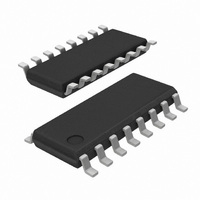SI3019-KS Silicon Laboratories Inc, SI3019-KS Datasheet - Page 33

SI3019-KS
Manufacturer Part Number
SI3019-KS
Description
IC VOICE DAA GCI/PCM/SPI 16SOIC
Manufacturer
Silicon Laboratories Inc
Type
Chipsetr
Datasheet
1.SI3056-KS.pdf
(96 pages)
Specifications of SI3019-KS
Package / Case
16-SOIC (3.9mm Width)
Function
Data Access Arrangement (DAA)
Interface
GCI, PCM, SPI
Number Of Circuits
1
Voltage - Supply
3 V ~ 3.6 V
Current - Supply
8.5mA
Operating Temperature
0°C ~ 70°C
Mounting Type
Surface Mount
Includes
Line Voltage Monitor, Loop Current Monitor, Overload Detection, Parallel Handset Detection, Polarity Reversal Detection, TIP and
Product
Modem Chip
Supply Voltage (min)
3 V
Supply Current
8.5 mA
Maximum Operating Temperature
+ 70 C
Minimum Operating Temperature
0 C
Mounting Style
SMD/SMT
Lead Free Status / RoHS Status
Contains lead / RoHS non-compliant
Power (watts)
-
Lead Free Status / RoHS Status
Lead free / RoHS Compliant, Contains lead / RoHS non-compliant
Available stocks
Company
Part Number
Manufacturer
Quantity
Price
Part Number:
SI3019-KS
Manufacturer:
SILICON LABS/芯科
Quantity:
20 000
Company:
Part Number:
SI3019-KSR
Manufacturer:
SILICONLAB
Quantity:
2 722
2. The DAA must then check for another parallel device
line data. The host processor must detect the
presence of this tone.
on the same line. This is accomplished by briefly
going on-hook, measuring the line voltage, and then
returning to an off-hook state.
a. Set the CALD bit (Register 17, bit 5) to disable
b. Set the RCALD bit (Register 25, bit 5) to disable
c. Set the FOH[1:0] bits (Register 31, bits 6:5) to 11
d. Clear the OH bit (or drive the OFHK pin to the
e. Read the LVS bits to determine the state of the
the calibration that automatically occurs when
going off-hook.
the resistor calibration from occurring when
going off-hook.
to reduce the off-hook counter time to 8 ms.
inactive state) to put the DAA in an on-hook
state. The RXM bit (Register 19, bit 3) may also
be set to mute the receive path.
line.
If the LVS bits read the typical on-hook line
voltage, then no parallel devices are active on
the line and CID data reception can be
continued.
If the LVS bits read well below the typical on-
hook line voltage, then one or more devices are
present and active on the same line that are not
compliant with Type II CID. Do not continue CID
data reception.
Rev. 1.03
3. The CO then responds with the CID data and the
4. The muting of the upstream data path by the host
5. The CALD and RCALD bits can be cleared to re-
Because of the nature of the low-power ADC, the data
presented on SDO could have up to a 10% dc offset.
The caller ID decoder must either use a high pass or a
band pass filter to accurately retrieve the caller ID data.
host processor unmutes the upstream data output
and continues with normal operation.
processor mutes the handset in a telephone
application so the user cannot hear the
acknowledgement tone and CID data being sent.
enable the automatic calibration when going off-
hook. The FOH[1:0] bits also can be programmed to
01 to restore the default off-hook counter time.
f. Set the OH bit to 1 (or drive the OFHK pin to the
active state) to return to an off-hook state. After
returning to an off-hook state and waiting 8 ms
for the off-hook counter, normal data
transmission and reception can proceed. If a
non-compliant parallel device is present, then a
reply tone is not sent by the host tone generator
and the CO does not proceed with sending the
CID data. If all devices on the line are Type II CID
compliant, then the host must mute its upstream
data output to avoid propagation of its reply tone
and the subsequent CID data. After muting its
upstream data output, the host processor should
then return an acknowledgement (ACK) tone to
the CO to request the transmission of the CID
data.
Si3018/19/10
33












